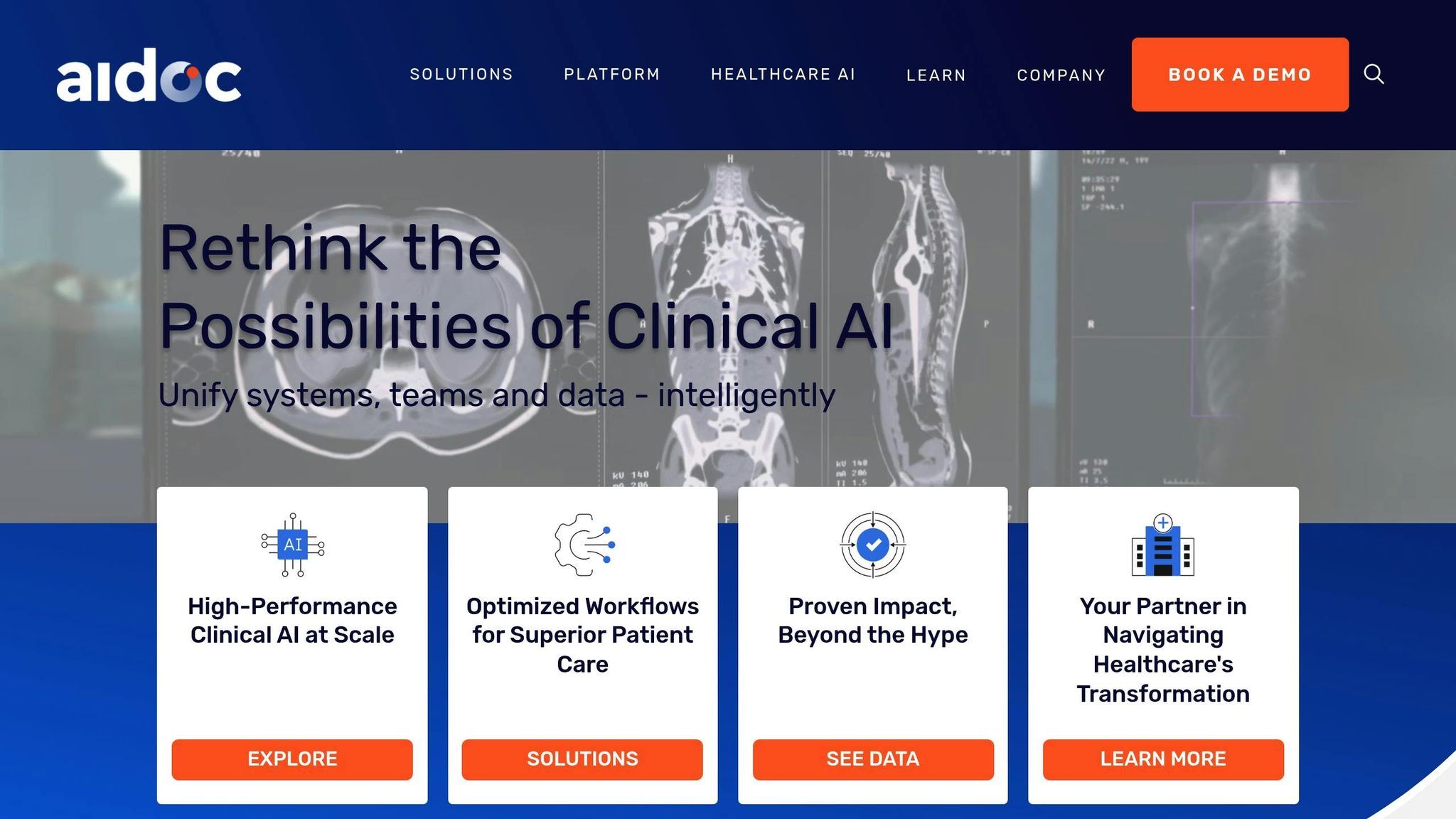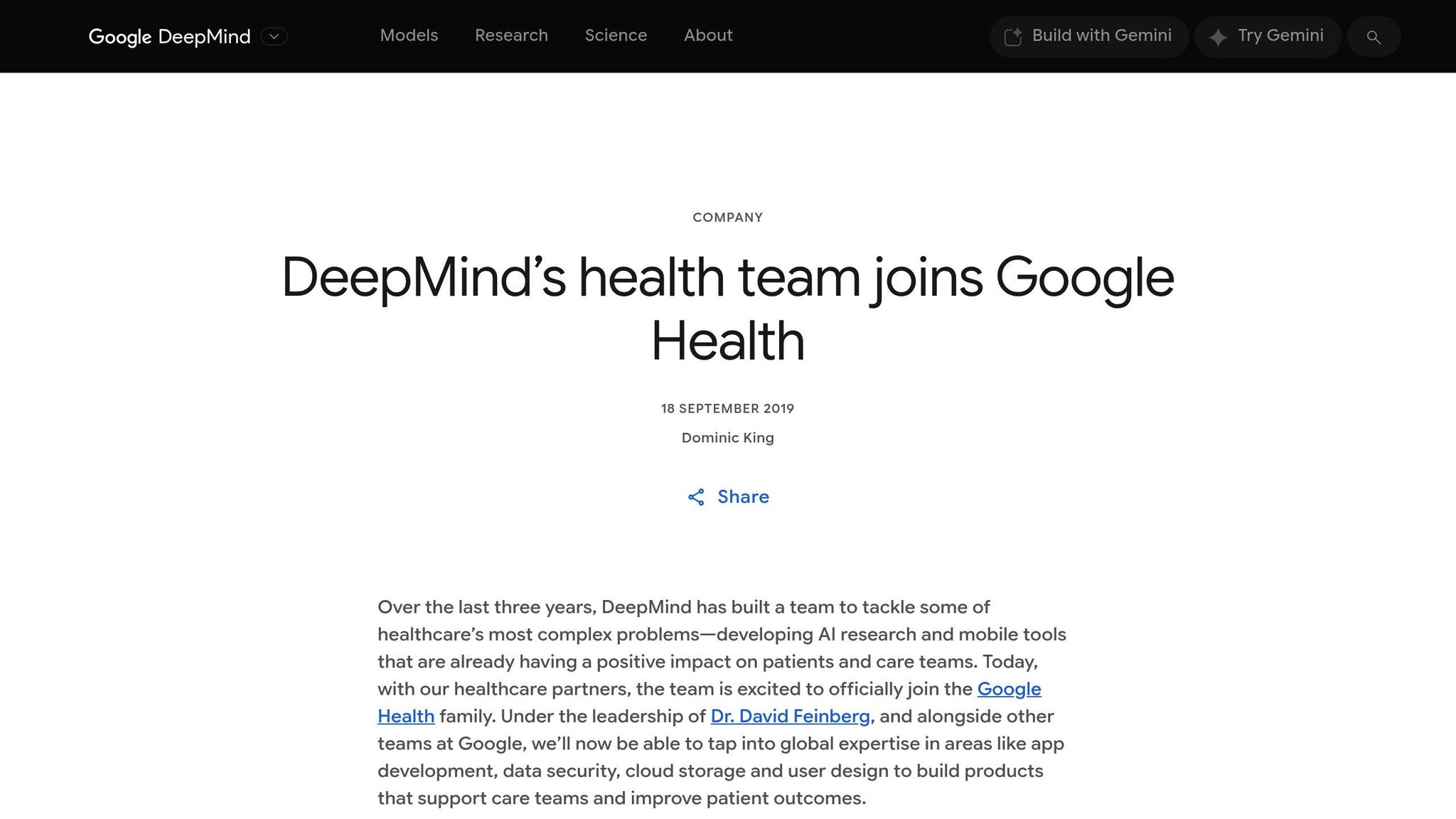
The U.S. healthcare system is leveraging AI to tackle challenges like rising costs, staff shortages, and administrative inefficiencies. AI is projected to save the industry up to $360 billion annually, with 65% of U.S. hospitals already using AI tools for predictive analytics, triage, and automation. By 2030, the global healthcare AI market is expected to grow from $28 billion in 2024 to over $180 billion.
Key AI tools driving this shift include:
AI is improving efficiency, reducing errors, and enabling better patient care. For example, Auburn Community Hospital saw a 40% increase in coder productivity, while AI-assisted mammograms boosted cancer detection rates by 17.6%. As the technology evolves, healthcare organizations must address integration challenges, data privacy, and staff training to fully realize AI's potential.
AI workflow automation is reshaping U.S. healthcare, streamlining operations and improving the way care is delivered. From cutting administrative burdens to enhancing clinical decision-making, it’s driving efficiency, lowering costs, and improving patient experiences.
Administrative work takes up nearly 30% of the U.S. healthcare budget, with doctors and staff spending almost half their time on tasks like paperwork and Electronic Health Record (EHR) management. AI is stepping in to ease this load.
Scheduling and Patient Management
Manual scheduling often leads to no-show rates as high as 30%. AI-based systems have cut these rates by 30% and reduced staff scheduling time by 60%. For example, Intermountain Healthcare saw a 25% drop in patient check-in times and a 300% increase in co-payment collections after adopting Notable's AI for intake and registration.
Prior Authorization and Insurance Processing
AI tools now handle tasks like reviewing insurance policies and patient histories, automating simple approvals and managing appeals. Notable Health’s platform, used in over 12,000 care sites, automates millions of these processes daily, speeding up approvals and improving cash flow.
Streamlined Clinical Documentation
Ambient AI scribes are saving physicians valuable time. At The Permanente Medical Group, most doctors using these tools reclaim about an hour each day. Similarly, Hattiesburg Clinic in Mississippi saw a reduction in after-hours documentation and a 17% increase in job satisfaction during a pilot program.
"Reducing administrative burdens that add hours onto the workday are the biggest hope that physicians have for how augmented intelligence (AI) - often referred to as artificial intelligence - can change their workplace for the better."
– American Medical Association
Data Accuracy and Error Reduction
AI achieves data extraction accuracy rates above 99%, far surpassing the 1–5% accuracy typical of manual processes. This translates to fewer errors and reduced rework.
These efficiency improvements not only save time but also support better decision-making.
AI enhances clinical decisions by analyzing vast data sets and offering real-time insights. It supplements medical expertise with data-driven recommendations and predictive analytics.
Diagnostic Accuracy
AI is making strides in diagnostics. For breast cancer, AI systems analyzing mammograms reduced false positives by 5.7% and false negatives by 9.4%, outperforming traditional methods. In South Korea, AI demonstrated 90% sensitivity in detecting breast cancer with mass, compared to 78% for radiologists. It also excelled in identifying early-stage cancer (91% vs. 74%). Similarly, AI algorithms for pneumonia detection achieved 96% sensitivity, compared to radiologists’ 50%. For acute appendicitis, a random forest algorithm predicted cases with 83.75% accuracy and 84.11% precision.
Predictive Analytics and Treatment Optimization
AI is also helping clinicians anticipate and prevent critical conditions. For instance, Google has developed predictive models that alert healthcare providers to risks like sepsis and heart failure before symptoms appear. Platforms like CURATE.AI adjust chemotherapy doses based on individual patient data, improving response rates while minimizing treatment intensity compared to traditional approaches.
The FDA has recognized the potential of AI, approving around 950 AI/ML-enabled medical devices as of August 2024, with many focused on radiology.
"AI can help us learn new approaches to treatment and diagnostic testing for some cases that can reduce uncertainty in medicine."
– Dr. Maha Farhat, Associate Physician of Pulmonary and Critical Care at Massachusetts General Hospital
AI’s role extends beyond diagnostics, contributing to cost savings and better resource allocation.
AI automation offers substantial financial benefits, helping healthcare providers and payers save money while optimizing resources.
Operational Cost Reductions
Hospitals can cut operational costs by 20–30% with AI-driven automation and predictive analytics. For payers, the savings could reach up to 35%. Globally, AI has the potential to save $360 billion annually, with U.S. healthcare expected to save around $100 billion in the pharmaceutical sector alone.
Supply Chain and Process Efficiency
AI-powered systems streamline inventory management, reducing hospital operation costs by 5–10%. Additionally, automation can shorten cycle times by 30–50%. For example, Microsoft’s InnerEye technology reduces preparation time for radiotherapy planning by up to 90%.
Real-World Savings Examples
Topflight’s GaleAI automates charge tagging, cutting coding efforts by 97% and boosting revenue by up to 15% for early adopters. Auburn Community Hospital reported a 40% increase in coder productivity and halved the number of cases awaiting final billing after implementing AI tools.
"The industry has the potential to save upwards of $20 billion by shifting to more automated workflows, alleviating administrative burden, and allowing for more concerted efforts to improve patient care and access."
– Pranay Kapadia, Notable Health
Regulatory Efficiency
In 2025, the FDA introduced Elsa, a generative AI tool designed to assist with clinical protocol reviews. Elsa speeds up the evaluation process, leading to quicker regulatory approvals.
These cost efficiencies contribute to a smoother patient experience and improved safety.
AI is transforming patient care by reducing wait times, enhancing communication, and improving safety measures.
Reduced Wait Times and Improved Access
AI-powered intake systems handle tasks like verifying insurance and completing forms electronically, cutting wait times and easing front desk congestion. Baptist Health South Florida achieved a 40% reduction in patient wait times through AI-optimized scheduling.
Enhanced Communication and Support
Automated reminders, follow-ups, and virtual assistants ensure patients receive timely updates while reducing the workload for call centers. Buoy Health’s AI-powered assistant, for instance, provides personalized guidance for patients with COVID-19 symptoms.
Error Reduction and Safety Improvements
Tools like Topflight’s Mi-Life, a HIPAA-compliant voice chatbot, give caregivers hands-free access to patient data in real-time, reducing medication errors and boosting staff satisfaction.
Improved Clinical Outcomes
AI aids in early detection and treatment, as seen in diabetic retinopathy screening. Remidio’s smartphone-based fundus cameras make screenings more accessible, while the FDA-approved AI algorithm "IDx-DR" has been recognized for its diagnostic accuracy and cost-effectiveness.
Mental Health Support
AI is also expanding access to mental health care. Chatbots provide personalized support, helping with early detection and treatment. Livongo, for example, sends targeted notifications to encourage healthier choices.
The U.S. healthcare system is evolving rapidly, with specialized AI agents driving measurable progress in clinical operations and patient care. These tools are making targeted improvements in areas like radiology, documentation, revenue management, and imaging. Each AI solution addresses specific challenges, showcasing how technology can boost efficiency and enhance patient outcomes.

Aidoc's AI, cleared by the FDA, is designed to detect critical conditions like collapsed lungs in X-ray images. By automatically flagging urgent cases, it helps radiologists prioritize their workload, ensuring that critical patients receive timely attention. Its integration with existing radiology systems simplifies adoption and enhances workflow efficiency.

Nuance DAX (Dragon Ambient eXperience) is an advanced clinical intelligence tool that captures and organizes patient-provider conversations in real time. At Intermountain Health, a study involving 99 providers across 12 specialties showed that DAX reduced documentation time from 5.3 to 4.54 minutes per patient and lowered 24-hour documentation deficiency rates from 9.9% to 6.3%. Kaiser Permanente piloted DAX with over 1,000 physicians across 63,000 patient encounters, reporting high satisfaction - 47% of ratings were 5-star, and 31% were 4-star. Since then, it has supported over 4 million patient encounters.
A Microsoft survey conducted in July 2024 among 879 clinicians using DAX Copilot revealed that the tool saved an average of 5 minutes per encounter while improving documentation quality and work-life balance.
"Kaiser Permanente adopted and scaled AI clinical documentation technology to respond to growing physician strain and burnout from the long hours they spend documenting patient care, both in the office and at home late into the evening." – Brian Hoberman, MD, Chief Information Officer, The Permanente Federation
Beyond basic note-taking, DAX Copilot offers advanced features like generating referral letters, summarizing clinical data, creating after-visit summaries, and coaching providers to ensure documentation is thorough.

Administrative tasks in healthcare, such as insurance verification and claims processing, benefit greatly from automation. Olive AI handles these revenue cycle tasks, including prior authorizations, with impressive scale - processing over 46 million requests in 2022 alone. By integrating seamlessly with existing systems, Olive AI reduces administrative burdens, allowing healthcare providers to focus more on patient care.

DeepMind Health has been at the forefront of applying AI to medical imaging. For example, its 'Sepsis Watch' system at Duke Health in North Carolina reviews data every five minutes, doubling the effectiveness of sepsis detection. At Cleveland Clinic, an AI tool analyzes EEG data in intensive care units, detecting seizures in seconds. In July 2025, Microsoft introduced a diagnostic AI orchestrator that reportedly outperformed physicians on complex cases. These advancements highlight how AI integration in clinical workflows can improve diagnostic precision and support timely medical interventions.
Rolling out AI in healthcare isn't as simple as flipping a switch. It involves navigating a maze of technical hurdles, regulatory requirements, and organizational dynamics. To ensure success, healthcare providers must carefully plan and address key areas like system integration, data privacy, staff training, and financial viability.
Bringing AI into the fold of existing EHR systems - like Epic, Cerner, or Allscripts - can be a daunting task. Many of these systems were not built with AI in mind, and the lack of standardized data formats makes seamless data sharing a challenge. This scattered data landscape complicates patient analysis and slows down the process. To tackle this, focusing on interoperability standards like HL7 and FHIR is essential. Starting with departments or use cases that promise a high return on investment can help ease the process.
"The integration of AI into existing EHR systems often requires substantial technical modifications. Existing infrastructures may not be equipped to handle the high-speed data processing and storage that AI applications demand."
– Sully.ai
"For AI to be effectively deployed in healthcare, it is imperative to establish formats and protocols that facilitate seamless information exchange across different institutions and AI platforms."
– Christian Rose, Department of Emergency Medicine, Stanford University School of Medicine
A phased approach works best. Instead of overhauling the entire system at once, starting small allows teams to identify and resolve technical challenges early. Once integration is successful, the focus shifts to safeguarding patient data and meeting regulatory requirements.
When dealing with Protected Health Information (PHI), AI systems must adhere strictly to HIPAA guidelines. This means limiting data access to only what’s necessary and ensuring patient information is de-identified using Safe Harbor or Expert Determination methods. AI vendors must also sign Business Associate Agreements, and regular audits should be conducted to ensure compliance.
HIPAA’s "minimum necessary" rule plays a vital role here. AI systems must be configured to access only the specific data needed for their intended function. Robust controls and oversight are critical to maintaining this standard.
"AI is a powerful enabler in digital health, but it amplifies privacy challenges. By aligning AI practices with HIPAA, conducting vigilant oversight, and anticipating regulatory developments, Privacy Officers can safeguard sensitive information and promote compliance and innovation in the next era of digital health."
– Foley & Lardner LLP
De-identifying patient data is especially crucial when training AI models. Using HIPAA-compliant methods to anonymize data helps protect against re-identification risks. Additionally, updating the Notice of Privacy Practices to explain how AI systems use patient data can build transparency and trust with patients.
Even the most advanced AI tools won’t succeed without proper training and buy-in from healthcare staff. Clear communication about how AI enhances - not replaces - clinical expertise is key.
"AI's greatest potential lies not in replacing healthcare professionals, but in amplifying their capabilities and deepening their impact on patient care."
– Thoughtful
Role-specific training programs are particularly effective. For example, physicians might focus on how AI aids in diagnosis, while nurses could learn how it simplifies documentation and patient monitoring. Peer training models, where "super users" or "clinical champions" are designated within departments, can also drive adoption. These individuals receive in-depth training and act as on-the-ground resources for their colleagues. MedSys Group successfully used this approach during a major tech rollout, achieving high adoption rates and improved workflows within just a month.
Ongoing support is equally important. Offering help desk assistance, refresher courses, and quick-reference materials ensures staff can continue to adapt and use AI tools effectively.
AI implementation in healthcare comes with a hefty upfront price tag. Costs include software licenses, hardware upgrades, integration services, and staff training. However, the potential savings are massive. By 2026, healthcare AI could save up to $150 billion annually, largely by improving workforce efficiency and streamlining operations.
For example, automating routine administrative tasks could save up to 47% of administrators’ time, freeing them to focus on more impactful responsibilities. Evaluating ROI means looking beyond direct cost savings to consider indirect benefits like better patient satisfaction and fewer medical errors. Pilot programs can provide valuable data to justify further investment and expansion.
AI technologies are reshaping healthcare in ways that were unimaginable just a few years ago. Three major trends are at the forefront of this transformation: ambient AI that works quietly within clinical workflows, no-code platforms enabling anyone to build AI tools, and intelligent systems driving value-based care. Let’s take a closer look at how these advancements are creating new opportunities.
Ambient AI is designed to work behind the scenes, seamlessly integrating into clinical workflows. Unlike traditional AI tools that need user input, ambient technologies operate autonomously, processing patient information during interactions without disrupting the flow of care.
One standout innovation in this space is ambient clinical documentation. This technology listens to conversations between patients and providers, automatically generating clinical notes in real time. A Stanford University pilot study in 2024 showed how these AI scribes cut documentation time significantly, freeing up clinicians to focus on patient care.
By handling time-consuming documentation tasks, ambient AI reduces administrative burdens, giving healthcare providers more time for what matters most - caring for their patients.
Another game-changer is the rise of no-code platforms, which allow healthcare staff to create AI solutions without needing programming expertise. These platforms empower non-technical users to quickly build and deploy automations, reducing the reliance on IT teams.
"No-code platforms enable non-technical users, like citizen developers, to build and deploy AI automations rapidly. This reduces IT dependency, accelerates implementation, lowers total cost of ownership, and frees up staff to focus on improving patient experiences rather than repetitive manual tasks."
Healthcare organizations have seen impressive results with these tools. For instance, automation projects have reduced manual work by up to 70% and completed tasks up to 10 times faster than traditional methods. In some cases, the return on investment is so fast that these solutions pay for themselves in just six weeks.
A great example of this is Inland Empire Health Plan (IEHP). In 2025, their team used no-code tools to launch an AI-driven outreach campaign, contacting 1.5 million members in a matter of weeks. The result? A doubled response rate and full compliance - all without requiring IT intervention.
Modern no-code platforms now come with hundreds of pre-built connectors, making it easier than ever to integrate systems like electronic health records, billing software, and customer management tools. This flexibility allows healthcare organizations to adapt quickly to new regulations, test ideas, and improve processes in a fraction of the time it used to take.
AI is also playing a pivotal role in the shift toward value-based care, where the focus is on proactive, outcomes-driven healthcare. With the value-based care market expected to grow from $12.2 billion in 2023 to $43.4 billion by 2031, AI tools are becoming essential for managing this transition.
Predictive analytics and risk stratification are two standout applications. For example, Jefferson City Medical Group (JCMG) used AI for risk stratification in 2025, leading to a 20% drop in hospital readmissions for diabetic patients and a 15% reduction for chronic heart failure patients. Similarly, Montage Health implemented AI-powered prior authorization processes in 2023, cutting authorization work queue volume by 22%, saving 300 staff hours monthly, and processing over 5,600 authorization checks in a year.
AI is also transforming how labor-intensive tasks are handled. At JCMG, an AI tool from Navina identified patients overdue for colorectal cancer screenings in just one hour - a task that would have taken 40–50 hours manually. This efficiency improvement helped boost their Medicare Star Rating for this measure to a perfect 5 stars.
"What would have taken somebody 40–50 hours, to manually go in and abstract that patient information from records, took us an hour using AI." - Ron Rockwood, Executive Director of Value-Based Care at Jefferson City Medical Group
The key to success lies in integrating AI seamlessly into existing workflows. Tools that require clinicians to step outside their normal routines often struggle with adoption. The most effective solutions embed AI directly into electronic health record systems, ensuring smooth implementation without disrupting patient care.
As value-based care becomes the norm, AI will play an even greater role in unifying data to create a complete picture of each patient’s care journey. With an estimated 80% of healthcare data currently unstructured, technologies like Generative AI and Natural Language Processing hold enormous potential to uncover insights that improve outcomes and lower costs.
AI agents are reshaping healthcare operations in the United States, evolving from tools that assist with diagnoses to systems capable of autonomously managing workflows. Beyond enhancing efficiency and improving diagnostics, AI is now addressing some of the most pressing workforce and financial challenges in American healthcare.
The numbers speak volumes. The global healthcare AI market is projected to skyrocket from $11.2 billion in 2023 to $427.5 billion by 2032, growing at an astonishing 47.6% annual rate. This marks one of the most transformative technological shifts in healthcare history. Today, 86% of medical organizations are already using AI, with 60% acknowledging its ability to detect health patterns and diagnoses beyond human capabilities.
The financial benefits are equally striking. AI is expected to save up to $150 billion in costs by 2026, including slashing administrative expenses by as much as 30%. Real-world examples back these claims. At Mass General Brigham, intelligent automation has saved 271,000 staff hours and generated $10 million in cost savings.
"AI agents represent the next transformational wave in healthcare, moving beyond simple diagnosis tools to autonomous systems that can schedule appointments, create detailed medical reports, and monitor patients remotely without human intervention."
– Bernard Marr, Contributor, Forbes
AI’s impact is being felt across the board. In radiology, AI boosts diagnostic accuracy by up to 20%, while in clinical documentation, AI scribes have reduced administrative tasks by 69.5% in laboratory environments. The U.S. FDA has already approved nearly 950 AI-driven medical devices, most of which are designed for disease detection and diagnosis.
One of AI's most critical contributions lies in addressing workforce shortages. By 2026, there is a projected 10% shortage of registered nurses, amounting to 350,540 unfilled positions. Meanwhile, administrative costs consume 15% to 30% of all U.S. healthcare spending. AI automation is no longer just an option - it’s becoming essential for the system’s survival.
The shift from reactive to proactive care is already happening. AI agents are enabling predictive analytics to identify at-risk patients before complications arise, crafting personalized treatment plans based on genetic and medical histories, and providing 24/7 patient support to enhance engagement while cutting costs. Studies show that AI achieves correct diagnoses in 91% of cases.
"AI agents can now be used to manage many of the complex workflows that often bog down staff. These intelligent agents can involve people when necessary to clear roadblocks and ensure oversight. This frees up valuable time to focus on what truly matters: For clinicians, that's providing exceptional patient care, and for those at health insurance companies, that's ensuring a seamless and cost-effective experience for their members."
– Carlos Pardo Martin, Partner, McKinsey
To maximize these benefits, AI must complement human expertise with proper oversight. Addressing challenges like data privacy, ensuring HIPAA compliance, and achieving seamless integration with electronic health records (EHR) are critical steps. Data privacy, in particular, remains a top concern, with 72% of respondents identifying it as a significant risk.
The future of healthcare in the U.S. hinges on the effective use of AI agents to improve care and streamline operations. With over 80% of organizations planning to maintain or expand their investments in automation, and 80% expected to adopt intelligent automation by 2025, the focus isn’t on whether to implement AI - it’s on how quickly and strategically it can be done. These advancements illustrate the immense potential of AI to revolutionize the healthcare landscape.
AI is making waves in healthcare by taking over time-consuming tasks such as medical billing, coding, and documentation. By automating these repetitive duties, healthcare professionals can lighten their administrative load, reducing burnout and allowing them to dedicate more energy to patient care.
On top of that, AI-driven tools are reshaping how staffing is managed. These tools provide real-time recommendations and simplify scheduling, making operations run more smoothly. The result? Fewer staffing gaps, faster processes, and a more seamless healthcare experience for both providers and patients.
When incorporating AI into existing EHR/EMR systems, healthcare organizations need to focus on compatibility and data standardization to ensure everything runs smoothly. Tackling interoperability issues, protecting data privacy and security, and addressing limitations of older systems are critical steps for a successful rollout.
It's equally important to factor in the cost of integration, invest in comprehensive staff training, and anticipate potential resistance to change. Keeping the system efficient over time requires ongoing monitoring and regular updates to adapt to evolving needs.
AI is transforming healthcare by analyzing intricate medical data, like imaging and patient records, with a level of precision that's hard to match. This capability enables earlier detection of diseases and the creation of treatment plans tailored to individual patients. The result? Improved patient outcomes, including increased survival rates and a higher standard of care.
Beyond improving care, AI is also helping to cut healthcare costs. By reducing unnecessary procedures, optimizing workflows, and making diagnostics more efficient, it not only saves money but also enhances the overall delivery of healthcare services.





